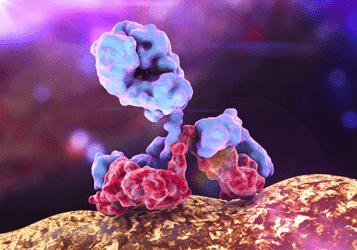- Home
- Products
- Customized ADCs
- FcRH5
- Anti-FcRH5-SPDB-DM4 ADC-3
Anti-FcRH5-SPDB-DM4 ADC-3 (CAT#: ADC-W-137)
This ADC product is comprised of an anti-FcRH5 monoclonal antibody (clone 10A8) conjugated via a SPDB linker to DM4. The DM4 is targeted to certain cancers by immunerecognition and delivered into cancer cells via receptor mediated endocytosis. Within the cell, DM4 binds to tubulins, interrupts microtubule dynamics, and subsequently, induces cell death.
- Product Information
- ADC Target
- ADC Antibody
- ADC Linker
- ADC payload drug
- Antibody clone #
- 10A8
- Name
- FcRH5
- Alternative Names
- FCRL5; Fc receptor-like 5; CD307; FCRH5; IRTA2; BXMAS1; CD307e; PRO820; Fc receptor-like protein 5; fcR-like protein 5; fc receptor homolog 5; immune receptor translocation-associated protein 2; immunoglobulin superfamily receptor translocation associated
- Target Entrez Gene ID
- 83416
- Target UniProt ID
- Q96RD9
- Overview
- This gene encodes a member of the immunoglobulin receptor superfamily and the Fc-receptor like family. This gene and several other Fc receptor-like gene members are clustered on the long arm of chromosome 1. The encoded protein is a single-pass type I membrane protein and contains 8 immunoglobulin-like C2-type domains. This gene is implicated in B cell development and lymphomagenesis. Alternatively spliced transcript variants encoding different isoforms have been identified.
- Overview
- Anti-FcRH5 antibody, clone # 10A8
- Clone #
- 10A8
- Species Reactivity
- Human
- Name
- SPDB (N-succinimidyl-4-(2-pyridyldithio)butyrate)
- Description
- Disulfide Linkers, are extensively exploited as a chemically labile linkage. Since the release of disulfide-linked drugs requires a cytoplasmic thiol cofactor, such as glutathione (GSH). Disulfides maintain stable at physiological pH and only when ADCs are internalized inside cells, the cytosol provides reducing environment including intracellular enzyme protein disulfide isomerase, or similar enzymes, drugs can be released.
- Name
- DM4 (N2'-Deacetyl-N2'-(4-mercapto-4-methyl-1-oxopentyl)maytansine)
- Description
- Derived from Maytansinoid,a group of cytotoxins structurally similar to rifamycin, geldanamycin, and ansatrienin. The eponymous natural cytotoxic agent maytansine is a 19-member lactam (ansa
macrolide) structure originally isolated from the Ethiopian shrub Maytenus ovatus. Maytansinoids can bind to tubulin at or near the vinblastine-binding site, which interfere the formation of microtubules and depolymerize already formed microtubules, inducing mitotic arrest in the intoxicated cells.
For Research Use Only. NOT FOR CLINICAL USE.
Related Products
- Anti-CEACAM5 (Altumomab)-MC-MMAF ADC (CAT#: ADC-W-970)
- Anti-TNFSF4 (Oxelumab)-SMCC-DM1 ADC (CAT#: ADC-W-1916)
- Anti-NECTIN4-VC-MMAE ADC (CAT#: ADC-W-477)
- Anti-PDGFR (Olaratumab)-MC-Vc-PAB-SN38 ADC (CAT#: ADC-W-1710)
- Anti-CD3D (Teplizumab)-SPDB-DM4 ADC (CAT#: ADC-W-831)
- Anti-CD22-SPDB-DM4 ADC (CAT#: ADC-W-2528)
- Anti-EphA4-calicheamicin ADC (CAT#: ADC-W-556)
- Anti-TNFRSF8-Mc-PABC-MMAE ADC-12 (CAT#: ADC-W-342)
- Anti-Fibrin II-beta chain (Biciromab)-SPDB-DM4 ADC (CAT#: ADC-W-1995)
- Anti-CSF2-MC-MMAF ADC (CAT#: ADC-W-2308)
Published Data
+ Submit Publications

Scientific Resources
Customer Reviews and FAQs
There are currently no Customer reviews or questions for ADC-W-137. Click the button above to contact us or submit your feedback about this product.
Quick Links
Other Products
Same Target
Same Linker
Same Payload
| CAT# | Product Name | Linker | Payload |
| ADC-W-130 | Anti-FcRH5-SMCC-DM1 ADC-1 | SMCC (N-succinimidyl 4-(Nmaleimidomethyl)cyclohexane-1-carboxylate) | DM1 (N2’-Deacetyl-N2’-(3-mercapto-1-oxopropyl)maytansine) |
| ADC-W-131 | Anti-FcRH5-SMCC-DM1 ADC-2 | SMCC (N-succinimidyl 4-(Nmaleimidomethyl)cyclohexane-1-carboxylate) | DM1 (N2’-Deacetyl-N2’-(3-mercapto-1-oxopropyl)maytansine) |
| ADC-W-138 | Anti-FcRH5-Mc-VC-PABC-MMAE ADC-3 | MC-VC-PABC (maleimidocaproyl-valine-citrulline-p-aminobenzoyloxycarbonyl) | MMAE (Monomethyl auristatin E) |
| ADC-W-133 | Anti-FcRH5-SMCC-DM1 ADC-4 | SMCC (N-succinimidyl 4-(Nmaleimidomethyl)cyclohexane-1-carboxylate) | DM1 (N2’-Deacetyl-N2’-(3-mercapto-1-oxopropyl)maytansine) |
| ADC-W-134 | Anti-FcRH5-SMCC-DM1 ADC-5 | SMCC (N-succinimidyl 4-(Nmaleimidomethyl)cyclohexane-1-carboxylate) | DM1 (N2’-Deacetyl-N2’-(3-mercapto-1-oxopropyl)maytansine) |
| CAT# | Product Name | Linker | Payload |
| ADC-W-480 | Anti-CD33-SPDB-DM4 ADC-6 | SPDB (N-succinimidyl-4-(2-pyridyldithio)butyrate) | DM4 (N2'-Deacetyl-N2'-(4-mercapto-4-methyl-1-oxopentyl)maytansine) |
| ADC-W-095 | Anti-LAMP1-SPDB-DM4 ADC-1 | SPDB (N-succinimidyl-4-(2-pyridyldithio)butyrate) | DM4 (N2'-Deacetyl-N2'-(4-mercapto-4-methyl-1-oxopentyl)maytansine) |
| ADC-W-2605 | Anti-ITGB3 (Tadocizumab)-SPDB-DM4 ADC | SPDB (N-succinimidyl-4-(2-pyridyldithio)butyrate) | DM4 (N2'-Deacetyl-N2'-(4-mercapto-4-methyl-1-oxopentyl)maytansine) |
| ADC-W-2599 | Anti-GPNMB (Glembatumumab)-SPDB-DM4 ADC | SPDB (N-succinimidyl-4-(2-pyridyldithio)butyrate) | DM4 (N2'-Deacetyl-N2'-(4-mercapto-4-methyl-1-oxopentyl)maytansine) |
| ADC-W-422 | Anti-ITGAV-SPDB-DM4 ADC | SPDB (N-succinimidyl-4-(2-pyridyldithio)butyrate) | DM4 (N2'-Deacetyl-N2'-(4-mercapto-4-methyl-1-oxopentyl)maytansine) |
| CAT# | Product Name | Linker | Payload |
| ADC-W-516 | Anti-FOLR1-SPDB-DM4 ADC-5 | SPDB (N-succinimidyl-4-(2-pyridyldithio)butyrate) | DM4 (N2'-Deacetyl-N2'-(4-mercapto-4-methyl-1-oxopentyl)maytansine) |
| ADC-W-2599 | Anti-GPNMB (Glembatumumab)-SPDB-DM4 ADC | SPDB (N-succinimidyl-4-(2-pyridyldithio)butyrate) | DM4 (N2'-Deacetyl-N2'-(4-mercapto-4-methyl-1-oxopentyl)maytansine) |
| ADC-W-2616 | Anti-MS4A1-SPDB-DM4 ADC | SPDB (N-succinimidyl-4-(2-pyridyldithio)butyrate) | DM4 (N2'-Deacetyl-N2'-(4-mercapto-4-methyl-1-oxopentyl)maytansine) |
| ADC-W-324 | Anti-CD19-SPDB-DM4 ADC-3 | SPDB (N-succinimidyl-4-(2-pyridyldithio)butyrate) | DM4 (N2'-Deacetyl-N2'-(4-mercapto-4-methyl-1-oxopentyl)maytansine) |
| ADC-W-480 | Anti-CD33-SPDB-DM4 ADC-6 | SPDB (N-succinimidyl-4-(2-pyridyldithio)butyrate) | DM4 (N2'-Deacetyl-N2'-(4-mercapto-4-methyl-1-oxopentyl)maytansine) |
Online Inquiry
Welcome! For price inquiries, please feel free to contact us through the form on the left side. We will get back to you as soon as possible.



